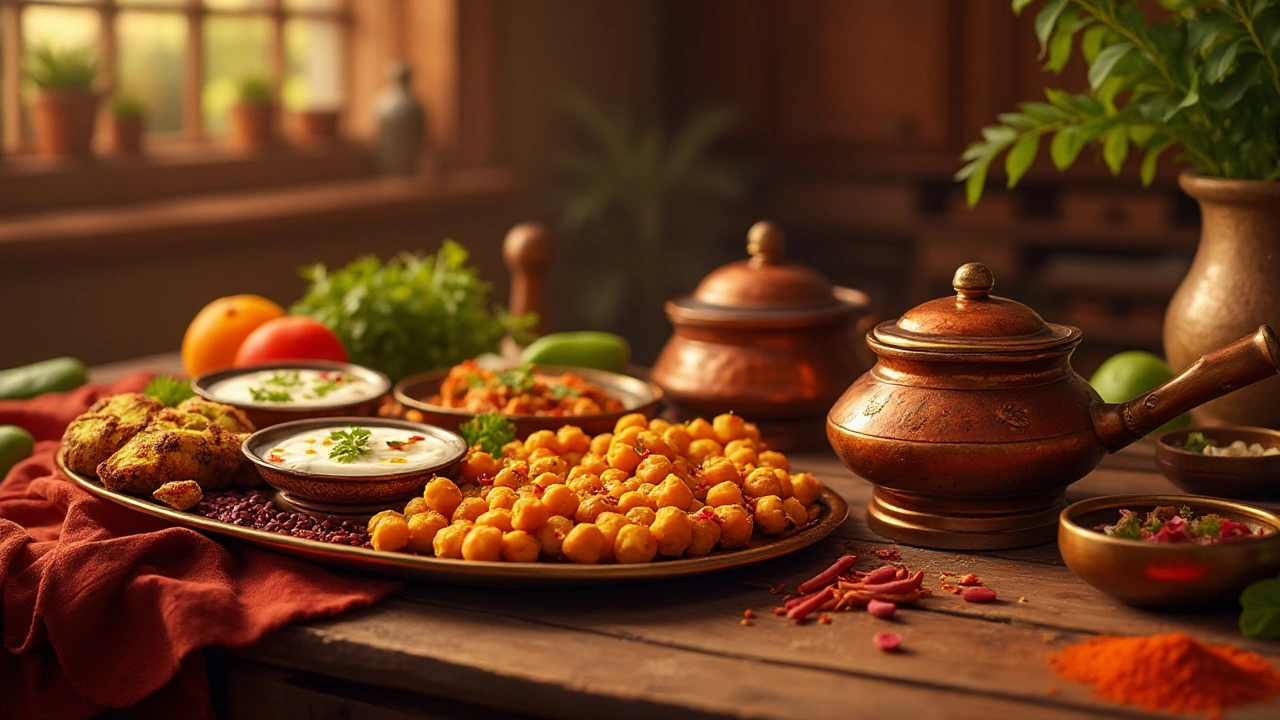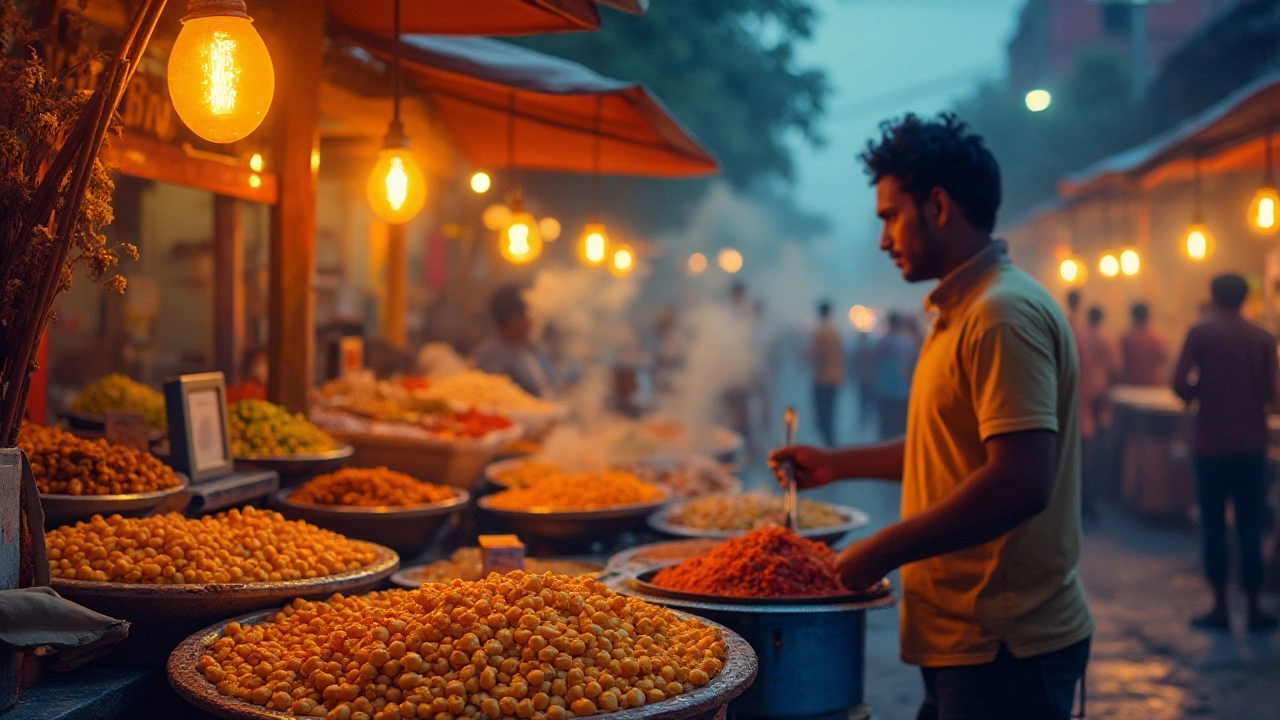Picture this: the day is drawing to an end, and your stomach begins to rumble in anticipation of that perfect evening snack. But instead of reaching for something ordinary, why not indulge in a delightful blend of taste and health? India's culinary landscape offers a variety of options that cater not only to the palate but also to the well-being of your body. These snacks are not just about satisfying hunger—they're a celebration of flavor and nutrition.
In this vibrant collection, we dive into wholesome choices that do more than just fill your stomach. They invigorate your senses, fortify your energy levels, and add a dash of spice to your routine. Whether you're craving something crunchy, tangy, or cooling, Indian snacks have something exotic and enriching to offer. Let's embark on this snacking journey, keeping health and happiness at the forefront.
- Roasted Delight: Chickpeas and Peanuts
- Fermented Wonders: Dhokla and Idli
- Flavorful Crunch: Murmura and Bhel Puri
- Cooling Treats: Cucumber Raita and Fruit Chaat
Roasted Delight: Chickpeas and Peanuts
In the realm of healthy snacks, roasted chickpeas and peanuts emerge as unsung heroes, brimming with flavor and nutrients. These crunchy delights are not only perfect for munching but also packed with essential vitamins and minerals, making them an ideal choice for those aiming to combine taste with nutrition.
A Nutrient Powerhouse
Chickpeas, also known as garbanzo beans, are celebrated for their high protein and fiber content. They are an excellent vegan protein source, making them a staple in Indian households. When roasted, they become irresistibly crunchy, providing a guilt-free snack option that's rich in folate, iron, and phosphorus.
Peanuts, on the other hand, are filled with heart-healthy fats and antioxidants like resveratrol, which are known to aid cardiovascular health. Roasting them enhances their nutty flavor and creates a satisfying snack that can help manage weight by promoting a feeling of fullness.
Simple Yet Versatile
The beauty of roasted chickpeas and peanuts lies in their versatility. Whether you're adding spices for a spicy kick or keeping them plain and salted, the variety of flavors you can achieve is limitless. Here’s a simple recipe to get you started:
- Preheat your oven to 375°F (190°C).
- Drain and rinse a can of chickpeas, then pat them dry.
- Toss chickpeas with olive oil, salt, and spices of your choice—think cayenne, paprika, or cumin for a traditional Indian twist.
- Spread evenly on a baking sheet and roast for 30-40 minutes, stirring occasionally, until golden and crispy.
- For peanuts, simply mix with a bit of salt and roast in the same manner until you get a rich brown color.
Why Opt For Roasted?
Roasting these snacks not only elevates their taste but also ensures they retain their nutritional value. Deep-frying may add unwanted calories, whereas roasting allows you to keep the goodness intact. This method is ideal if you're looking to maintain a diet focused on nutritious food without sacrificing flavor.
Roasted chickpeas and peanuts also have an impressively long shelf life, making them a handy snack to store and enjoy at any time. Here's a glimpse of their nutritional benefits:
| Component | Chickpeas | Peanuts |
|---|---|---|
| Proteins | 15g per 100g | 25g per 100g |
| Dietary Fiber | 7g per 100g | 10g per 100g |
| Iron | 2.9mg per 100g | 4.6mg per 100g |
As you explore these roasted Indian snacks, you'll find that they not only satisfy your taste buds but also support a balanced, healthy lifestyle.
Fermented Wonders: Dhokla and Idli
In the realm of Indian snacks, few can rival the delightful appeal of dhokla and idli, both revered for their exquisite taste and exceptional health benefits. These traditional snacks not only tantalize your taste buds but also nurture your gut health, courtesy of the fermentation process they undergo.
The Nutritional Benefits of Fermentation
Fermentation is a time-honored method that enhances the nutritional profile of food by enhancing its digestibility and increasing beneficial probiotics. These good bacteria are known to boost your immune system, improve gut flora, and aid digestion. As a result, fermented foods like dhokla and idli are more than just delectable—they're a passport to better health.
Dhokla: The Tangy Savory Snack
Originating from the western state of Gujarat, dhokla is a steamed cake made from a fermented batter of rice and chickpea flour (besan). Its mildly sour flavor, punctuated by a tadka of mustard seeds, curry leaves, and green chilies, makes it an irresistible snack option.
Adding to its appeal, dhokla is low in calories yet packed with essential nutrients such as protein, fiber, and vitamins. It's a brilliant dish for those looking to maintain a balanced diet without compromising on taste.
Idli: The Soft Steamed Cakes
From the southern parts of India comes the fluffy idli, crafted from a fermented batter of rice and urad dal (black gram). Renowned for its softness and subtle flavor, idli is typically served alongside an array of chutneys and sambar, making it a versatile snack or meal component.
Beyond its appealing texture, idli is a powerhouse of nutrients. High in protein and low in fat, it provides sustained energy, making it a perfect choice for those mid-evening hunger pangs that require a nutritious fix.
Crafting Dhokla and Idli at Home
- Begin with the fermentation process by soaking rice and lentils (urad dal for idli, chickpea flour for dhokla) for 4-6 hours.
- Grind the soaked ingredients to a smooth batter and allow it to ferment overnight or until it rises significantly.
- For dhokla, season the batter with spices and steam it until firm. For idli, pour the fermented batter into molds and steam until soft and fluffy.
With just a bit of planning, you can transform simple ingredients into these traditional delicacies that are sure to elevate your evening snack experience.

Flavorful Crunch: Murmura and Bhel Puri
Murmura and Bhel Puri are not just snacks; they are experiences filled with savory excitement and texture. These healthy snacks are ubiquitous in Indian households, beloved by millions for their crunchy and tangy symphony of flavors.
What is Murmura?
Murmura, also known as puffed rice, forms the backbone of this crunchy delight. It’s low in calories yet high in volume, making it a perfect choice for those who enjoy munching without the guilt. A single cup of murmura contains only about 50 calories and is naturally light, providing a great base for additional flavors.
The Nutritional Profile
While largely composed of carbohydrates, murmura offers a trace amount of proteins and is fortified with iron. Its low-fat content makes it an ideal choice for those managing their weight.
Crafting the Perfect Bhel Puri
Bhel Puri elevates murmura to another level by incorporating a mélange of ingredients. It's not just a snack; it's a burst of flavors. Traditional bhel puri includes finely chopped onions, tomatoes, green chilies, and fresh coriander. A sprinkling of tangy tamarind chutney and spicy mint chutney takes the flavor quotient to new heights.
Steps to Prepare Bhel Puri
- Start with two cups of murmura in a large bowl.
- Add a quarter cup of finely chopped onions and tomatoes.
- Mix in two tablespoons of mint and tamarind chutneys.
- Garnish with a handful of roasted peanuts and sev (crunchy chickpea flour noodles).
- Sprinkle fresh coriander and a squeeze of lemon before serving.
Customization is key with bhel puri. Feel free to add diced boiled potatoes or raw mango for a seasonal twist.
Interesting Facts
- Bhel puri is traditionally a street food, enjoyed by people of all ages, bringing communities together over shared joy and laughter.
- It's believed to have originated in the bustling city of Mumbai, reflecting the vibrant and fast-paced life of the metropolis.
By savoring bhel puri, you're not just enjoying a snack, but participating in a cultural tradition that celebrates India's diverse culinary backdrop. Why settle for the mundane when you can elevate your evening with something as distinctly delicious and nutritious as murmura and bhel puri?
Cooling Treats: Cucumber Raita and Fruit Chaat
When the temperature starts to rise, or if a particularly fiery curry has you reaching for a cool-down, it's time to talk about two iconic Indian snacks that bring both refreshment and a burst of flavor to the table: cucumber raita and fruit chaat.
Nature's Chill: Cucumber Raita
Cucumber raita is more than just a side dish; it's a soothing companion that complements a spicy meal or stands alone as a refreshing snack. Combining cooling cucumber, creamy yogurt, and a medley of spices, raita is designed to beat the heat both externally and internally.
- Hydration Highlight: With a water content of over 95%, cucumber is not just hydrating but also low in calories, making raita a guilt-free delight.
- Nutrition Galore: Yogurt is rich in probiotics which aid digestion, making cucumber raita a gut-friendly option.
To prepare, simply dice fresh cucumbers and mix them with a cup of yogurt. Add a pinch of roasted cumin powder, a dash of salt, and a sprinkle of finely chopped mint leaves. Want to spice it up? A hint of red chili powder adds a subtle kick while still keeping it refreshingly cool.
Fruit Chaat: A Symphony of Flavors
If your taste buds crave a combination of sweet, sour, and tangy, fruity options like fruit chaat are the way to go. This colorful concoction is a lively ensemble of seasonal fruits tossed in a tantalizing selection of spices.
The beauty of fruit chaat lies in its versatility and the nutritional rainbow it brings. Here's a simple recipe:
- Choose a variety of fresh fruits such as apples, bananas, pomegranates, and grapes. Dice into bite-sized pieces.
- Toss with a sprinkle of chaat masala, black salt, lime juice, and a touch of chili powder, according to your spice preference.
- Mix well and let it sit for a few minutes to allow the flavors to meld together.
This vibrant mix doesn't just tickle the palate but also serves up a hefty dose of vitamins and minerals. Consider this: while apples are a good source of Vitamin C and fiber, pomegranates add a punch of antioxidants.
Both cucumber raita and fruit chaat serve as perfect examples of how Indian cuisine effortlessly blends health and taste, proving that evening snacks can be both satisfying and nourishing.
